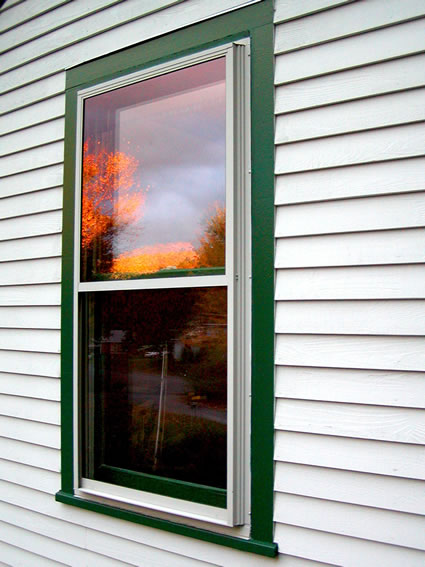Storm Window
Description
Storm windows are exterior windows added to cover and protect existing windows from weather and improve energy performance. High-performance, low-emissivity (low-e) exterior storm windows often have better seals, smoother long-term operation, and significantly better energy performance. Low-e coatings increase thermal insulation, which significantly reduces heat loss from the home’s interior during cold weather. Low-e coatings may also modestly reduce interior temperature increases from sunlight (solar heat gain). The lower the emissivity of the low-e coating, the better the energy performance of the storm window. The low-e coatings used on storm windows are highly durable and barely visible but give some texture to the window’s interior surface.
There are three basic types of exterior storm windows: triple-track (two operable glass panels and an operable screen), double-track (an operable lower panel and an operable screen), and fixed (one non-operable glass panel). More than 90% of storm windows are aluminum-framed because of the economy and durability of this design. Wood and vinyl storm windows are also available. Each type can be made with low-e glass panels. All modern low-e storm windows are more airtight than old-fashioned storm windows. Fixed panels are the most airtight, and double-tracks are more airtight than triple-tracks. Fixed-panel exterior storms may need to be removed seasonally to get full benefit when employed on operable windows.
Overall Thermal Performance
Exterior low-e storm windows, when properly installed and deployed, bring the overall thermal performance (airtightness and thermal insulation) of the window close to that of a new double-paned low-e window. Most current low-e storm windows are high solar heat gain, best suited for climates where the need for heating dominates. Low solar heat gain, low-e storm windows suited for climates where the need for cooling dominates are becoming available.
Key Benefits
- Significantly increase air tightness/insulating properties of window assembly
- Offer convenient, easy operation of storm, sash, and screen (unless fixed)
- Protect existing windows (less maintenance)
- Improve comfort near window
Key Drawbacks
- May conflict with historical codes or condominium regulations that prohibit changing windows’ exterior appearance
- Interfere with existing window operation (outswing casement and awning windows)
- Seasonal installation and removal (fixed panel exterior storms)
Aesthetics
- Low-profile and higher-quality storm windows possibly considered more attractive/acceptable than standard triple-track storm windows
- Higher-quality storm windows often available in variety of colors
- Interior storm panels possibly preferable if maintaining exterior appearance is important
Tips/Cautions
- Look for a specific term warranty (e.g. 5-year) or transferable lifetime warranty.
- Unless venting is required at the top of the window, choose double-track storm windows with just one operable glass sash.
- If living in a condominium or historic district, check with authorities before proceeding.
- Follow manufacturer’s cleaning instructions. Low-e coatings are tougher than plain glass, but some coatings may not be completely smooth, so a lint-free cloth is recommended.
- Keep weepholes open at sill to reduce condensation. Keeping the most airtight layer to the interior of the entire window assembly reduces condensation potential.
- Check with manufacturer for actual emissivity value of the low-e storm window. The lower the value, the better the insulation properties.
- Consider how storm windows will affect egress.
- Use caution in combining exterior low-e storms with double-pane windows that have spectrally-selective low-e or tinted surfaces because the combination may produce temperatures high enough to damage the insulated glazing unit.

Available as fixed panels or tracked two or three-panel attachments (shown here), exterior modern low-e storm windows are more energy efficient, more durable, and more attractive than older-generation storm windows.
Photo: Peter Yost
When To Consider
- Existing windows are in good shape but have poor energy and thermal comfort performance.
- Convenience of integral screens is desirable (e.g., for keeping bugs out).
- Protecting existing windows from the elements is important.
- In cold (heating-dominated) climates, where existing windows are single-glazed or double-glazed without low-e coating.
When to consider this retrofit—Ownership
| x | Homeowner |
| x | Apartment Renter – Long Term* |
| Apartment Renter – Short Term | |
| x | Live in a Condo* |
| x | Live in a Historical District* |
* When renter rules, condominium regulations, or historical codes preclude use of exterior storm windows, interior window panels may be an option.
When to consider this retrofit—Window conditions
| x | Existing window single-glazed |
| x | Existing window double-glazed, no low-e* |
| Existing window double-glazed with low-e |
* low-emissivity coating
Recommended Installer
| x | Do it Yourself |
| x | Contractor |
| x | Manufacturer or supplier |
Complementary Options
- Interior privacy such as blinds, drapes (for cold climate – insulated cellular shades)
- Operation
- Manual
Considerations
| 1 | 2 | 3 | 4 | 5 | |
| Ease of Installation (1 = easier) |
x (1st story) |
x (2nd story) |
|||
| Availability (1 = more available) |
x | ||||
| Cost (1 = lower cost) |
x (DIY) |
x (trade) |
Average Total Cost for 30- by 60-inch window
| Typical Cost | $150 |
Digging Deeper
Energy Modeling Tools for Professionals
| x | RESFEN |
| x | DOE Low-e Storm Calculator |
References
“Field Evaluation of Low-e Storm Windows”
“Measured Winter Performance of Storm Windows”
